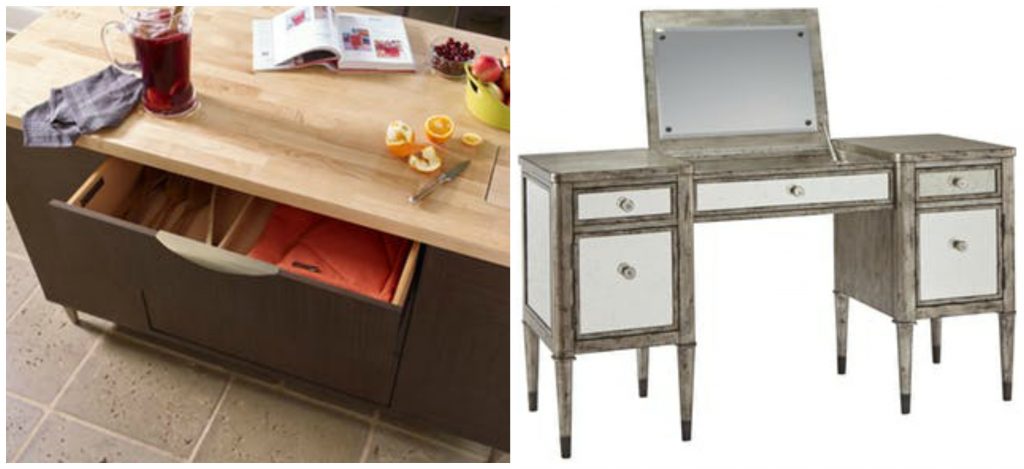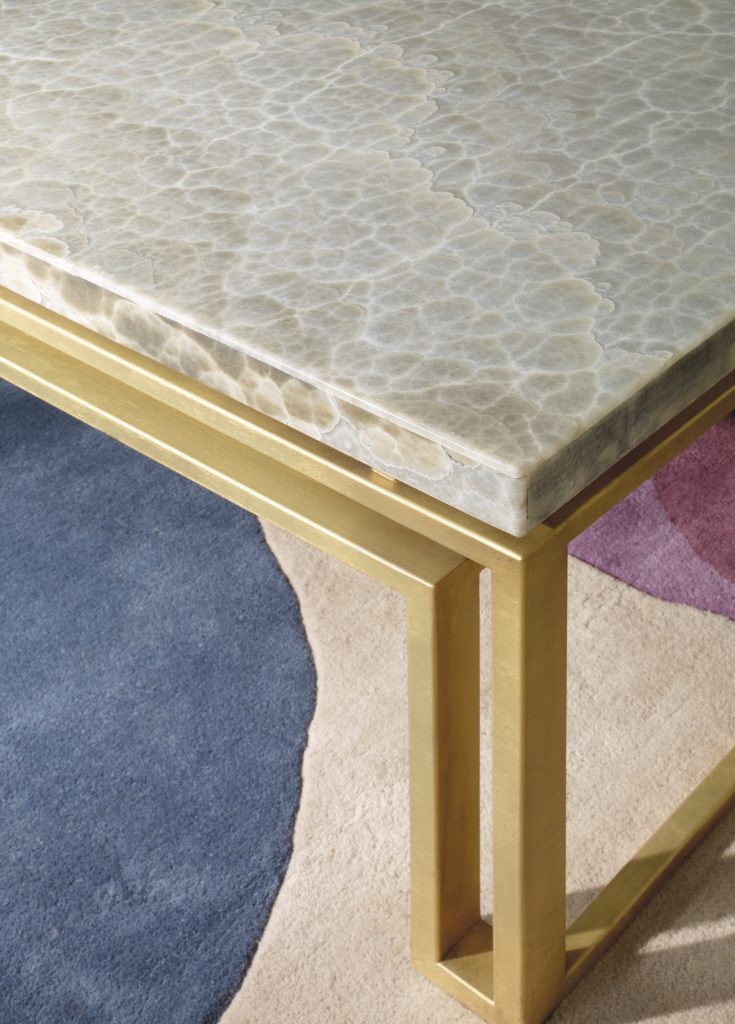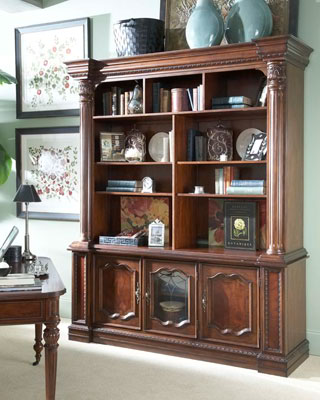Thursday, September 21st, 2017

Wood furnishings must be well-maintained when used inside bathrooms or kitchens. From left to right: Rachael Ray Home by Legacy Classic Furniture Kitchen Island Top 6020-190-T and the Fine Furniture Design Bedroom Madeline Vanity 1586-138.
There are many decluttering and cleaning tasks that you can postpone but when your home is pestered by household molds, then you had better roll up your sleeves and see what needs to be done. Molds can cause a plethora of health issues and they can even destroy the place where they are growing on.
Molds are fungi spores that commonly float on air. They then cling to surfaces that are damp. There, they grow and then gradually consume the very surface where they have been residing at. The key to a mold-free environment is to do the cleaning even before molds take root.
More on Molds
Molds are able to produce allergens that cause allergic reactions in a few people. Some of the indicators include hay fever-like symptoms. What’s worse is that not all biocides or chemicals can kill molds. In fact, there are cleaners that are not able to annihilate the mold population and these end up causing more allergic reactions.
Apart from killing the mold, it pays to have them removed. Here are some cleanup tips –
Find Their Hideouts
The most common homes for molds include leaky plumbing, roofs, damaged floors, and even indoor humidity can lead to molds on your furnishings. Water and flood damages also often cause mold growth in just under 24 hours.
Just think of any place in your home where it is dark, damp, and unventilated and you already know the potential mold-forming zones. These are areas where water often travels including plumbing arteries, drains, crawl spaces, and walls that have plumbing from the ground bathroom to the bathrooms on the upper floors.
Mold Hot Spots
Regions that are also humid or damp tend to be the best spots for molds to grow. Arid areas are still not immune, though. Even buildings that you think are tightly sealed can still be improperly ventilated which can still cause moisture and eventual mold buildup.
Clean up cellars, basements, those areas behind or under your fridge, underneath the bathroom and kitchen sinks, behind walls, around your air-conditioning units, under your carpets, and around the window sills.
Mold can also go undetected behind wallpapers. Sometimes, it takes mold inspectors to find where they are hiding. Glue can actually act as a food source to molds.
What Is Mildew?
Mildew is a kind of fungi coating that forms on any damp surface. This generally grows in flat patterns and looks powdery gray or white.
Mold is much darker in color and is usually green or black. Unlike mildew that just grows on the surface, molds tend to take root and penetrate the surface where they’re at.
Time to Clean Up
If the mold buildup is on ceiling tiles, carpeting, wallpaper, drywall or any porous surface, then make sure that the item gets thrown right away. These materials make it impossible for you to totally remove the mold buildup especially when it has already taken root.
Molds also cultivate on the backside of your drywalls, also in wall cavities. Since this is so, it takes time before you see the problem on the surface.
DIY Mold Cleanup
Bleach. Mix a cup of bleach with ample water to concoct a gallon. Pour the solution to spray bottles and spray on those mold-infested areas. You can also use a cloth or sponge for your bleach solution.
Vinegar. Do not dilute. Use full-strength and spray onto the moldy surfaces. Wipe off with a clean cloth.
Baking soda. Make this baking ingredient your new best friend since it is renowned for its cleaning properties. For molds, mix half a teaspoon of baking soda with a gallon of water. Mix then scrub onto the moldy surface.
Rinse with water.
Tags: cleaning mold and mildew, McCreerys, McCreerys Home Furnishings, mold and mildew buildup, mold cleanup
Posted in Home Maintenance, Interior Design 101 | Comments Off on Say Goodbye to Molds: Your DIY Project
Tuesday, August 9th, 2016

The 1586-80110D-MULTI4 Serendipity Rectangle Cocktail Table is the kind of furniture that can withstand an upped level of moisture in your home.
There are but a few things that can wreak havoc when it comes to indoor air quality than moisture. The non-removal of water vapor could result in the formation of mold, an increase in the population of dust mites and condensation. You all know what would happen should these start to invade your home so it’s time to fix your moisture problem once and for all.
Knowing how to get rid of moisture issues begins with being able to tell if it has gotten into your home. So where does it all begin?
People Are the Culprit
You may or may not be surprised to learn that people are the leading culprits when it comes to the occurrence of water vapor inside homes. Did you know that even in the hottest and most humid months, moisture can get in? Yet the environmental factors pale in comparison to the moisture produced by cooking, showering, even your breathing.
A family consisting of four members can produce up to three gallons of water vapor daily. If you’re thinking that merely opening windows would solve your problems, well, think again. Rather than doing this because it could bring in more moisture into your home, it would be better to dehumidify the area.
Shading is yet another strategy that you could look into.
Spot the Moisture Buildup
So how do you know when moisture is already starting to build up? First, you might notice some water drops along the edges of your glass windows.
Look up and you might also be able to see some mold or mildew forming right where the ceiling and the wall meet. The damp smell that is associated with mildew is also a common telltale sign that moisture is trying to destroy your home.
Seeing these things only means that what you have is either a very old home or a poorly-designed new building. There could be thermal bridges where insulation is quite weak as it allows heat to escape at a quicker rate.
A home renovation or remodel should include a consultation with a building science expert. Ventilation and envelope should be properly-designed so that moisture issues can be avoided.
Beware of Unseen Moisture
There could also be widespread condensation happening inside the roofs, walls or slabs where the human eye won’t penetrate. Yet there are also telltale signs that would tell you something is happening in those hidden areas. Called interstitial condensation, the moisture is escaping towards a cooler environment right on the other side of the warmer wall. When this happens, you would observe that the wall would start to degrade. Also, the efficiency of the insulation would start to be reduced.

FFDM Antebellum Collection: Take care of furniture pieces made of hardwood if you suspect that there is an increased level of moisture in your home.
Concentrated Condensation
Spot this right at that point where the roof, wall and slab are assembled. These are often visibly wet so you don’t need a pair of glasses to see where the plumbing issues are ensuing. This type of moisture intrusion is caused by an air leak that is localized, meaning, in just a single spot, there is a hole or crack where air escapes to the outside.
Should you know where to find the actual leak, then it is pretty easy to fix by simply checking the airtightness layer. At times, a simple blue tape could fortify punched areas.
Measure the Humidity
You might not see any of the above problems yet you know, somehow, that moisture is beginning to affect the indoor air quality in your home. If all you have is a gut feel, then it would be wise to invest in a hygrometer so you’ll know the levels of humidity in your home. The ideal measurement should be anywhere between 30 to 50 relative humidity.
Tags: controlling moisture buildup, controlling moisture in home, McCreerys, McCreerys Home Furnishings, moisture buildup, mold and mildew buildup, tips
Posted in Home Maintenance | No Comments »
© McCreery's Home Furnishings | All Rights Reserved | Privacy Policy